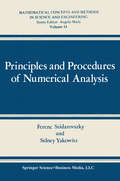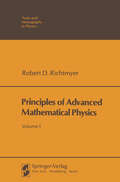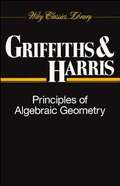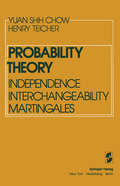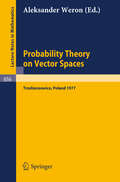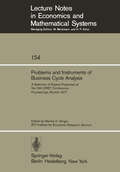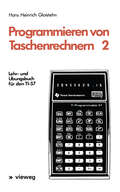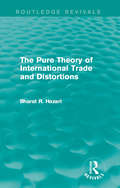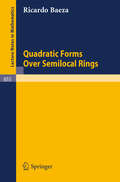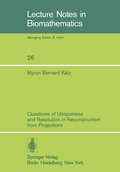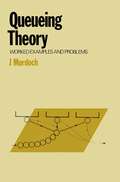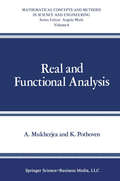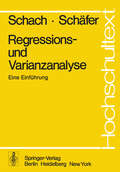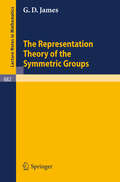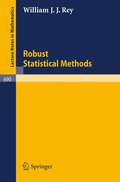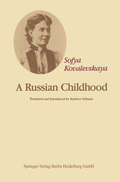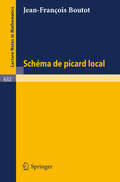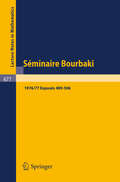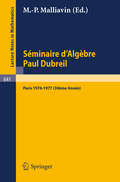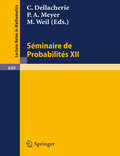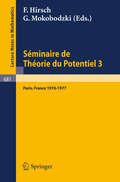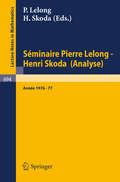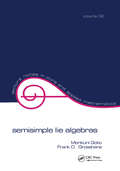- Table View
- List View
Principles and Procedures of Numerical Analysis (Mathematical Concepts and Methods in Science and Engineering #14)
by Ferenc Szidarovszky Sidney J. YakowitzIt is an incontestable fact that numerical analysis techniques are used rou tinely (although not always effectively) in virtually every quantitative field of scientific endeavor. In this book, which is directed toward upper-division and graduate level students in engineering and mathematics, we have selected for discussion subjects that are traditionally found in numerical analysis texts. But our choice of methodology rejects the traditional where analysis and experience clearly warrant such a departure, and one of our primary aspirations in this work is to equip the reader with the wherewithal to apply numerical analysis thinking to nontraditional subjects. For there is a plethora of computer-oriented sciences such as optimization, statistics, and system analysis and identification that are sorely in need of methods comparable to those related here for classical numerical analysis problems. Toward uncovering for the reader the structure of numerical methods we have, for example, devoted a chapter to a metric space theory for iter ative application of operators. In this chapter, we have collected those definitions and concepts of real and functional analysis that are requisite to a modern intermediate-level exposition of the principles of numerical anal ysis. Further, we derive the abstract theory (most notably, the contraction mapping theorem) for iteration processes.
Principles of Advanced Mathematical Physics (Theoretical and Mathematical Physics)
by Robert D. RichtmyerA first consequence of this difference in texture concerns the attitude we must take toward some (or perhaps most) investigations in "applied mathe matics," at least when the mathematics is applied to physics. Namely, those investigations have to be regarded as pure mathematics and evaluated as such. For example, some of my mathematical colleagues have worked in recent years on the Hartree-Fock approximate method for determining the structures of many-electron atoms and ions. When the method was intro duced, nearly fifty years ago, physicists did the best they could to justify it, using variational principles, intuition, and other techniques within the texture of physical reasoning. By now the method has long since become part of the established structure of physics. The mathematical theorems that can be proved now (mostly for two- and three-electron systems, hence of limited interest for physics), have to be regarded as mathematics. If they are good mathematics (and I believe they are), that is justification enough. If they are not, there is no basis for saying that the work is being done to help the physicists. In that sense, applied mathematics plays no role in today's physics. In today's division of labor, the task of the mathematician is to create mathematics, in whatever area, without being much concerned about how the mathematics is used; that should be decided in the future and by physics.
Principles of Algebraic Geometry (Wiley Classics Library #52)
by Phillip Griffiths Joseph HarrisA comprehensive, self-contained treatment presenting general results of the theory. Establishes a geometric intuition and a working facility with specific geometric practices. Emphasizes applications through the study of interesting examples and the development of computational tools. Coverage ranges from analytic to geometric. Treats basic techniques and results of complex manifold theory, focusing on results applicable to projective varieties, and includes discussion of the theory of Riemann surfaces and algebraic curves, algebraic surfaces and the quadric line complex as well as special topics in complex manifolds.
Principles of Algebraic Geometry (Wiley Classics Library #52)
by Phillip Griffiths Joseph HarrisA comprehensive, self-contained treatment presenting general results of the theory. Establishes a geometric intuition and a working facility with specific geometric practices. Emphasizes applications through the study of interesting examples and the development of computational tools. Coverage ranges from analytic to geometric. Treats basic techniques and results of complex manifold theory, focusing on results applicable to projective varieties, and includes discussion of the theory of Riemann surfaces and algebraic curves, algebraic surfaces and the quadric line complex as well as special topics in complex manifolds.
Probability Theory: Independence Interchangeability Martingales
by Y. S. Chow H. TeicherProbability theory is a branch of mathematics dealing with chance phenomena and has clearly discernible links with the real world. The origins of the sub ject, generally attributed to investigations by the renowned french mathe matician Fermat of problems posed by a gambling contemporary to Pascal, have been pushed back a century earlier to the italian mathematicians Cardano and Tartaglia about 1570 (Ore, 1953). Results as significant as the Bernoulli weak law of large numbers appeared as early as 1713, although its counterpart, the Borel strong law oflarge numbers, did not emerge until 1909. Central limit theorems and conditional probabilities were already being investigated in the eighteenth century, but the first serious attempts to grapple with the logical foundations of probability seem to be Keynes (1921), von Mises (1928; 1931), and Kolmogorov (1933). An axiomatic mold and measure-theoretic framework for probability theory was furnished by Kolmogorov. In this so-called objective or measure theoretic approach, definitions and axioms are so chosen that the empirical realization of an event is the outcome of a not completely determined physical experiment -an experiment which is at least conceptually capable of indefi nite repetition (this notion is due to von Mises). The concrete or intuitive counterpart of the probability of an event is a long run or limiting frequency of the corresponding outcome.
Probability Theory on Vector Spaces: Proceedings, Trzebieszowice, Poland, September 1977 (Lecture Notes in Mathematics #656)
by A WeronProblems and Instruments of Business Cycle Analysis: A Selection of Papers Presented at the 13th CIRET Conference Proceedings, Munich 1977 (Lecture Notes in Economics and Mathematical Systems #154)
by W. H. StrigelEvery two years the members of GIRET (= Centre for International Re search on Economic Tendency Surveys) meet at conferences in order to promote the scientific discussion and to encourage the exchange of ideas. CIRET is an international study group for research in the field of business cycle surveys. CIRET was founded in 1960 and has at present about 350 full and corresponding members in 35 different coun tries. The members either carry out business, investment or consumer 1 surveys or are working on a practical or methodological level with the results of such surveys. The most important topics of the GIRET conferences are the predictive value of survey data as trade cycle indicators, the utilization of qualitative data in econometric models, forecasts of capital expenditures based on plans of private companies, the usefulness of consumer surveys for trade cycle analyses. In September 1977 the 13th CIRET Conference took place in Munich. On the occasion of the three-day conference 27 papers were presented.
Programmieren von Taschenrechnern 2: Lehr- und Übungsbuch für den TI-57 (Programmieren von Taschenrechnern #2)
by Hans Heinrich GloistehnThe Pure Theory of International Trade and Distortions (Routledge Revivals)
by Bharat HazariFirst published in 1978. This book provides a simple, systematic, yet rigorous treatment of the key aspects of the pure theory of international trade and distortions. The opening chapter presents the standard two-factor, two-commodity barter model of international trade and a comprehensive treatment of the important properties and relationships. The rest of the book consists of four sections: parts One and Two are devoted to an analysis of factor market imperfections, and Parts Three and Four consider the trade-theoretical consequences of product market imperfections. A concluding chapter presents some generalised theorems. This book would be of interest to students of economics.
The Pure Theory of International Trade and Distortions (Routledge Revivals)
by Bharat HazariFirst published in 1978. This book provides a simple, systematic, yet rigorous treatment of the key aspects of the pure theory of international trade and distortions. The opening chapter presents the standard two-factor, two-commodity barter model of international trade and a comprehensive treatment of the important properties and relationships. The rest of the book consists of four sections: parts One and Two are devoted to an analysis of factor market imperfections, and Parts Three and Four consider the trade-theoretical consequences of product market imperfections. A concluding chapter presents some generalised theorems. This book would be of interest to students of economics.
Questions of Uniqueness and Resolution in Reconstruction from Projections (Lecture Notes in Biomathematics #26)
by M. B. KatzReconstruction from projections has revolutionized radiology and has now become one of the most important tools of medical diagnosis The E. M. I. Scanner is one example. In this text, some fundamental theoretical and practical questions are resolved. Despite recent research activity in the area, the crucial subject of the uniqueness of the reconstruction and the effect of noise in the data posed some unsettled fundamental questions. In particular, Kennan Smith proved that if we describe an object by a C^inf_o function, i.e., infinitely differentiable with compact support, then there are other objects with the same shape, i.e., support, which can differ almost arbitrarily and still have the same projections in finitely many directions. On the other hand, he proved that objects in finite dimensional function spaces are uniquely determined by a single projection for almost all angles, i.e., except on a set of measure zero. Along these lines, Herman and Rowland in "Three Methods for reconstructing objects from x-rays: a comparative study" (1973) showed that reconstructions obtained from the commonly used algorithms can grossly misrepresent the object and that the algorithm which produced the best reconstruction when using noiseless data gave unsatisfactory results with noisy data. Equally important are reports in Science, and personal communications by radiologists indicating that in medical practice failure rates of reconstruction vary from four to twenty percent. within this work, the mathematical dilemma posed by Kennan Smith's result is discussed and clarified.
Real and Functional Analysis (Mathematical Concepts and Methods in Science and Engineering)
by K. PothovenThis book introduces two most important aspects of modern analysis: the theory of measure and integration and the theory of Banach and Hilbert spaces. It is designed to serve as a text for first-year graduate students who are already familiar with some analysis as given in a book similar to Apostol's Mathematical Analysis. t This book treats in sufficient detail most relevant topics in the area of real and functional analysis that can be included in a book of this nature and size and at the level indicated above. It can serve as a text for a solid one-year course entitled "Measure and Integration Theory" or a com prehensive one-year course entitled "Banach Spaces, Hilbert Spaces, and Spectral Theory. " For the latter alternative, the student is, of course, required to have some knowledge of measure and integration theory. The breadth of the book gives the instructor enough flexibility to choose what is best suited for his/her class. Specifically the following alternatives are available: (a) A one-year course on "Measure and Integration" utilizing Chapters 1 (Sections l. l-1. 3 and 1. 6), 2, 3, 4, portions of 5 (information on Lp spaces), and portions of 7 (left to the discretion of the teacher). (b) A one-year course in "Functional Analysis" utilizing Chapters 1 (Sections 1. 4-1. 6), 5, 6, 7 (Sections 7. 4 and 7. 6), and the Ap pendix. t T. M. Apostol, Mathematical Analysis, 2nd ed. , Addison-Wesley (1974).
Séminaire Bourbaki: Vol. 1976/77. Exposés 489-506 (Lecture Notes in Mathematics #677)
by N. BourbakiSéminaire d'Algèbre Paul Dubreil: Proceedings. Paris 1976-1977 (30ème Année). (Lecture Notes in Mathematics #641)
by M. P. MalliavinSéminaire de Probabilités XII: Université de Strasbourg 1976/77 (Lecture Notes in Mathematics #649)
by C. Dellacherie P. A. Meyer M. WeilSéminaire de Théorie du Potentiel, Paris, 1976-1977, No. 3 (Lecture Notes in Mathematics #681)
by M. Brelot F. Hirsch G. Choquet G. Mokobodzki J. DenySéminaire Pierre Lelong - Henri Skoda: Année 1976-77 (Lecture Notes in Mathematics #694)
by P. Lelong H. SkodaSemisimple Lie Algebras
by Morikuni Goto Frank D. GrosshansThis book provides an account of part of the theory of Lie algebras most relevant to Lie groups. It discusses the basic theory of Lie algebras, including the classification of complex semisimple Lie algebras, and the Levi, Cartan and Iwasawa decompositions.
